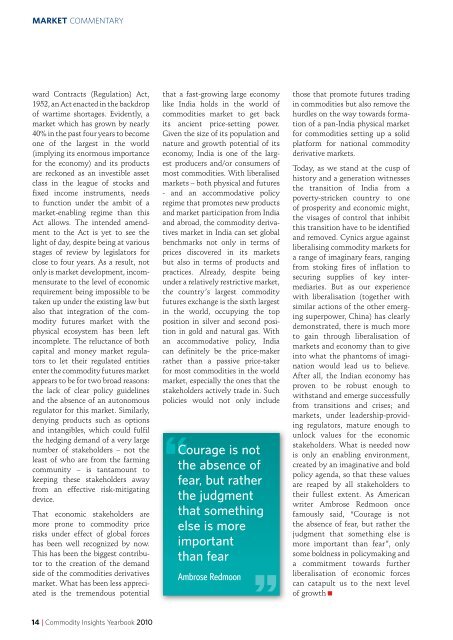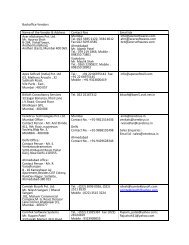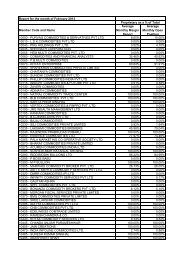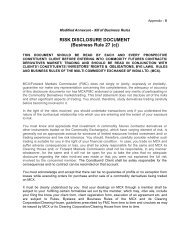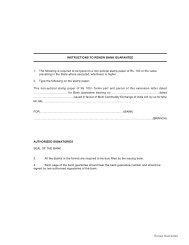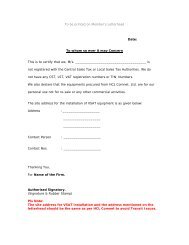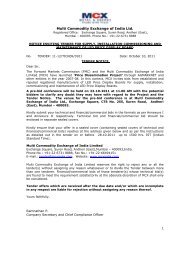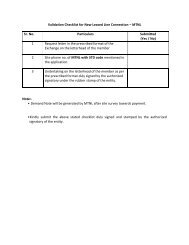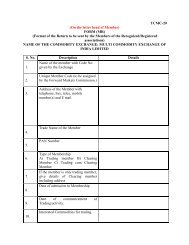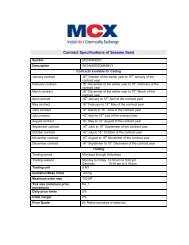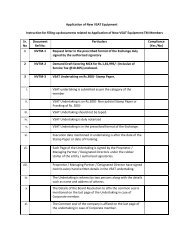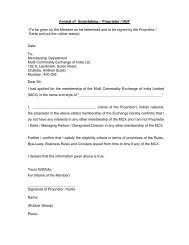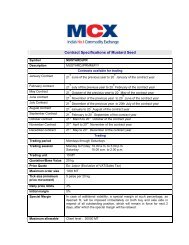Introduction, Contents, Foreword, From the Editorial Desk ... - MCX
Introduction, Contents, Foreword, From the Editorial Desk ... - MCX
Introduction, Contents, Foreword, From the Editorial Desk ... - MCX
You also want an ePaper? Increase the reach of your titles
YUMPU automatically turns print PDFs into web optimized ePapers that Google loves.
market CoMMENTARY<br />
ward Contracts (Regulation) Act,<br />
1952, an Act enacted in <strong>the</strong> backdrop<br />
of wartime shortages. Evidently, a<br />
market which has grown by nearly<br />
40% in <strong>the</strong> past four years to become<br />
one of <strong>the</strong> largest in <strong>the</strong> world<br />
(implying its enormous importance<br />
for <strong>the</strong> economy) and its products<br />
are reckoned as an investible asset<br />
class in <strong>the</strong> league of stocks and<br />
fixed income instruments, needs<br />
to function under <strong>the</strong> ambit of a<br />
market-enabling regime than this<br />
Act allows. The intended amendment<br />
to <strong>the</strong> Act is yet to see <strong>the</strong><br />
light of day, despite being at various<br />
stages of review by legislators for<br />
close to four years. As a result, not<br />
only is market development, incommensurate<br />
to <strong>the</strong> level of economic<br />
requirement being impossible to be<br />
taken up under <strong>the</strong> existing law but<br />
also that integration of <strong>the</strong> commodity<br />
futures market with <strong>the</strong><br />
physical ecosystem has been left<br />
incomplete. The reluctance of both<br />
capital and money market regulators<br />
to let <strong>the</strong>ir regulated entities<br />
enter <strong>the</strong> commodity futures market<br />
appears to be for two broad reasons:<br />
<strong>the</strong> lack of clear policy guidelines<br />
and <strong>the</strong> absence of an autonomous<br />
regulator for this market. Similarly,<br />
denying products such as options<br />
and intangibles, which could fulfil<br />
<strong>the</strong> hedging demand of a very large<br />
number of stakeholders – not <strong>the</strong><br />
least of who are from <strong>the</strong> farming<br />
community – is tantamount to<br />
keeping <strong>the</strong>se stakeholders away<br />
from an effective risk-mitigating<br />
device.<br />
That economic stakeholders are<br />
more prone to commodity price<br />
risks under effect of global forces<br />
has been well recognized by now.<br />
This has been <strong>the</strong> biggest contributor<br />
to <strong>the</strong> creation of <strong>the</strong> demand<br />
side of <strong>the</strong> commodities derivatives<br />
market. What has been less appreciated<br />
is <strong>the</strong> tremendous potential<br />
that a fast-growing large economy<br />
like India holds in <strong>the</strong> world of<br />
commodities market to get back<br />
its ancient price-setting power.<br />
Given <strong>the</strong> size of its population and<br />
nature and growth potential of its<br />
economy, India is one of <strong>the</strong> largest<br />
producers and/or consumers of<br />
most commodities. With liberalised<br />
markets – both physical and futures<br />
- and an accommodative policy<br />
regime that promotes new products<br />
and market participation from India<br />
and abroad, <strong>the</strong> commodity derivatives<br />
market in India can set global<br />
benchmarks not only in terms of<br />
prices discovered in its markets<br />
but also in terms of products and<br />
practices. Already, despite being<br />
under a relatively restrictive market,<br />
<strong>the</strong> country’s largest commodity<br />
futures exchange is <strong>the</strong> sixth largest<br />
in <strong>the</strong> world, occupying <strong>the</strong> top<br />
position in silver and second position<br />
in gold and natural gas. With<br />
an accommodative policy, India<br />
can definitely be <strong>the</strong> price-maker<br />
ra<strong>the</strong>r than a passive price-taker<br />
for most commodities in <strong>the</strong> world<br />
market, especially <strong>the</strong> ones that <strong>the</strong><br />
stakeholders actively trade in. Such<br />
policies would not only include<br />
Courage is not<br />
<strong>the</strong> absence of<br />
fear, but ra<strong>the</strong>r<br />
<strong>the</strong> judgment<br />
that something<br />
else is more<br />
important<br />
than fear<br />
Ambrose Redmoon<br />
those that promote futures trading<br />
in commodities but also remove <strong>the</strong><br />
hurdles on <strong>the</strong> way towards formation<br />
of a pan-India physical market<br />
for commodities setting up a solid<br />
platform for national commodity<br />
derivative markets.<br />
Today, as we stand at <strong>the</strong> cusp of<br />
history and a generation witnesses<br />
<strong>the</strong> transition of India from a<br />
poverty-stricken country to one<br />
of prosperity and economic might,<br />
<strong>the</strong> visages of control that inhibit<br />
this transition have to be identified<br />
and removed. Cynics argue against<br />
liberalising commodity markets for<br />
a range of imaginary fears, ranging<br />
from stoking fires of inflation to<br />
securing supplies of key intermediaries.<br />
But as our experience<br />
with liberalisation (toge<strong>the</strong>r with<br />
similar actions of <strong>the</strong> o<strong>the</strong>r emerging<br />
superpower, China) has clearly<br />
demonstrated, <strong>the</strong>re is much more<br />
to gain through liberalisation of<br />
markets and economy than to give<br />
into what <strong>the</strong> phantoms of imagination<br />
would lead us to believe.<br />
After all, <strong>the</strong> Indian economy has<br />
proven to be robust enough to<br />
withstand and emerge successfully<br />
from transitions and crises; and<br />
markets, under leadership-providing<br />
regulators, mature enough to<br />
unlock values for <strong>the</strong> economic<br />
stakeholders. What is needed now<br />
is only an enabling environment,<br />
created by an imaginative and bold<br />
policy agenda, so that <strong>the</strong>se values<br />
are reaped by all stakeholders to<br />
<strong>the</strong>ir fullest extent. As American<br />
writer Ambrose Redmoon once<br />
famously said, “Courage is not<br />
<strong>the</strong> absence of fear, but ra<strong>the</strong>r <strong>the</strong><br />
judgment that something else is<br />
more important than fear”, only<br />
some boldness in policymaking and<br />
a commitment towards fur<strong>the</strong>r<br />
liberalisation of economic forces<br />
can catapult us to <strong>the</strong> next level<br />
of growth<br />
14 | Commodity Insights Yearbook 2010


